

Abstract: Grids appear throughout the history of architecture. Since architects produce materials one step removed from their final intent, artifacts from the drawings used to create architecture live on in some form within their built result. The grid exemplifies such organizational drafting methods, carrying not only from representation to product but from professor to student as an accessible means by which to teach the complexities involved in architectural design. Numerous figures throughout the history of architecture have used the grid as a way to design, teach, and even redefine the theory and practice of architecture. The architect, theorist, and sculptor Pytheos of Priene, who predated Vitruvius and his treaties by approximately four centuries, rigorously implemented the grid in his designs, and presumably in his teachings and drawings, which have been lost to time. However, by examining other historical architects and pedagogues infatuated with the grid, further extrapolations on Pytheos' missing opinions appear in the clarification of the relationship between architecture and the grid, and propose an alternative foundation to architectural theory besides the well-trodden words of Vitruvius.
Architectural theory began before Vitruvius. His Ten Books on Architecture survived from ancient times, and have served as the definitive origin of architectural thought, but they were not the first. He writes this himself, naming several Greek architects who serve as the basis for his Roman retrospection. Among those is Pytheos, a fourth-century-ʙᴄᴇ architect known for his prominent works in Asia Minor. Pytheos employed an unusual design method—an uncompromising grid—in his Temple of Athena Polias at Priene (henceforth called the Athenaion) that stands out amongst his contemporaries, and with some examination, outlines a theory that predates and contrasts Vitruvius'. By examining the grid layout of the building with the assistance of two modern architects who also relied upon the uniformity and universality of the grid, Jean-Nicolas-Louis Durand of early-nineteenth-century France and John Hejduk of the late-twentieth-century United States, a speculative interpretation of Pytheos' theory emerges in the building, its drawings, and the teachings that stem from it.
The grouping of Pytheos, Durand, and Hejduk may seem chronologically absurd at first, but architectural theory has done away with temporal adherences since at least "Durand's somewhat casual attitude to history … entirely representative of the new and ambivalent relationship between theory and history that emerged with the demise of Vitruvianism."1 The leap of millennia proves useful in this regard as only after the reign of Vitruvius begins to collapse can glimpses of pre-Vitruvian architectural theory become conceivable once more. While little knowledge remains on Pytheos, strong links between him and his two modern counterparts are apparent: they all designed buildings adhering to a rigid grid, they all drew, and they all taught, thought, and held strong opinions about architecture.
While Vitruvius remains one of the few sources left to recall Pytheos' existence, the two did not agree on many matters, allowing Pytheos to provide an ancient name and the concomitant historical authority that it lends to this counter-tradition: that of the grid. Vitruvius plants his theory of architecture within definitions taken from the natural world, but architecture constructs artificial worlds within whatever context it finds itself built, making Vitruvius' claims themselves rich contradictions. Pytheos' gridded approach rivals Vitruvius' pseudo-natural one as art critic Rosalind Krauss posits about the grid in twentieth-century art:
In the spatial sense, the grid states the autonomy of the realm of art. Flattened, geometricized, ordered, it is antinatural, antimimetic, antireal. It is what art looks like when it turns its back on nature. In the flatness that results from its coordinates, the grid is the means of crowding out the dimensions of the real and replacing them with the lateral spread of a single surface. … The grid is a way of abrogating the claims of natural objects to have an order particular to themselves; the relationships in the aesthetic field are shown by the grid to be in a world apart and, with respect to natural objects, to be both prior and final. The grid declares the space of art to be at once autonomous and autotelic.2
Krauss' statements apply equally to architecture as they do to art, though they require a step back to compensate for the grid's limited role. It exists in the plan that produces the final architecture. The writings of Pytheos have been lost, but his architecture speaks to an unapologetic approach to building that sees the grid as a transcendental tool for architects to employ so that they may enforce order on the chaos of nature.
Pytheos' name comes down to the present day through a few ancient sources. Pliny the Elder credits him as an important sculptor on the Mausoleum of Halicarnassus—one of the seven wonders of the ancient world—who was responsible for the crowning quadriga on the building's pyramidal roof.3 Many have since claimed that Pytheos, with Satyros, was the architect of the Mausoleum.4 Vitruvius relays much more information, crediting him directly as the architect of the Athenaion at Priene.5 In addition to sculpting and building, Pytheos authored numerous texts on architecture, including two books on the two aforementioned structures.6 Another text, Commentaries, is also mentioned by Vitruvius, but it remains unclear whether this book is distinct from the book on the Athenaion that Vitruvius mentions later as he brings Commentaries up immediately after crediting Pytheos as the building's architect, with the implication that the building embodies Pytheos' architectural theory. Regardless, Pytheos built, wrote about building, and made arguments about the proper practice of architecture. His impact on other ancient architects and theorists, including Vitruvius himself, leaves enough of an imprint to set a basis of understanding on which to imagine a pre-Vitruvian treatise.
Leaping ahead two millennia to the late-eighteenth century, Durand's architectural career began with promise at a very early age. After leaving the Collège de Montaigu to pursue architecture, he worked at the office of Étienne-Louis Boullée for nearly five years before winning second place in the Grand Prix de l'Académie d'Architecture in 1780 at the age of twenty.7 He received his first house commission eight years later, and produced a collection of hundreds of drawings that "his contemporary Antoine Rondelet gave the title Rudimenta operis magni et disciplinae … (Rudiments of the Great Work and Discipline; ca. 1790)."8 Architects of his time saw his rapidly maturing potential; however, Durand's career would not take off until after the French Revolution when another competition victory—this time for a Temple of Equality, complete with a revolutionary order—won him enough prestige to secure a full-time position as a professor at the École Polytechnique, where he would remain until 1833, a year before his death.
Although very few of Durand's designs were constructed,A he designed prolifically. He intended to create architecture, not drawings, but his poor building record left most of his designs as merely that. Nevertheless, Durand dismissed the idea of glorifying drawings as they "can no more be the basis of the art than lettering the foundation of the sundry kinds of literature."9 To him, drawings were a means of representation and a route to architecture's true purpose of utility and disposition. They served another important purpose as well—that of instruction—and as a longstanding professor of a prestigious Parisian school, Durand drew architecture didactically. When he drew existing buildings, he modified them to make the drawings clearer than the buildings were in reality, bringing to the forefront the underlying design principles that he believed the architects had neglected as they developed their designs.10 The students he taught were engineers, and Durand taught only a seventh of their overall course load.11 Architecture was not their primary concern, which led Durand to develop a concise and easily digestible theory of architecture: the Précis. Unlike many of the copious other architectural treatises that had popped up since the Renaissance, Durand expressly rejected Vitruvius in his own. Like the engineers he taught, Durand sought rationality and precision. In this pursuit, his catalog of designs almost exclusively employs a grid layout, deviating from it only with the occasional circle or, rarer still, forty-five-degree angle.
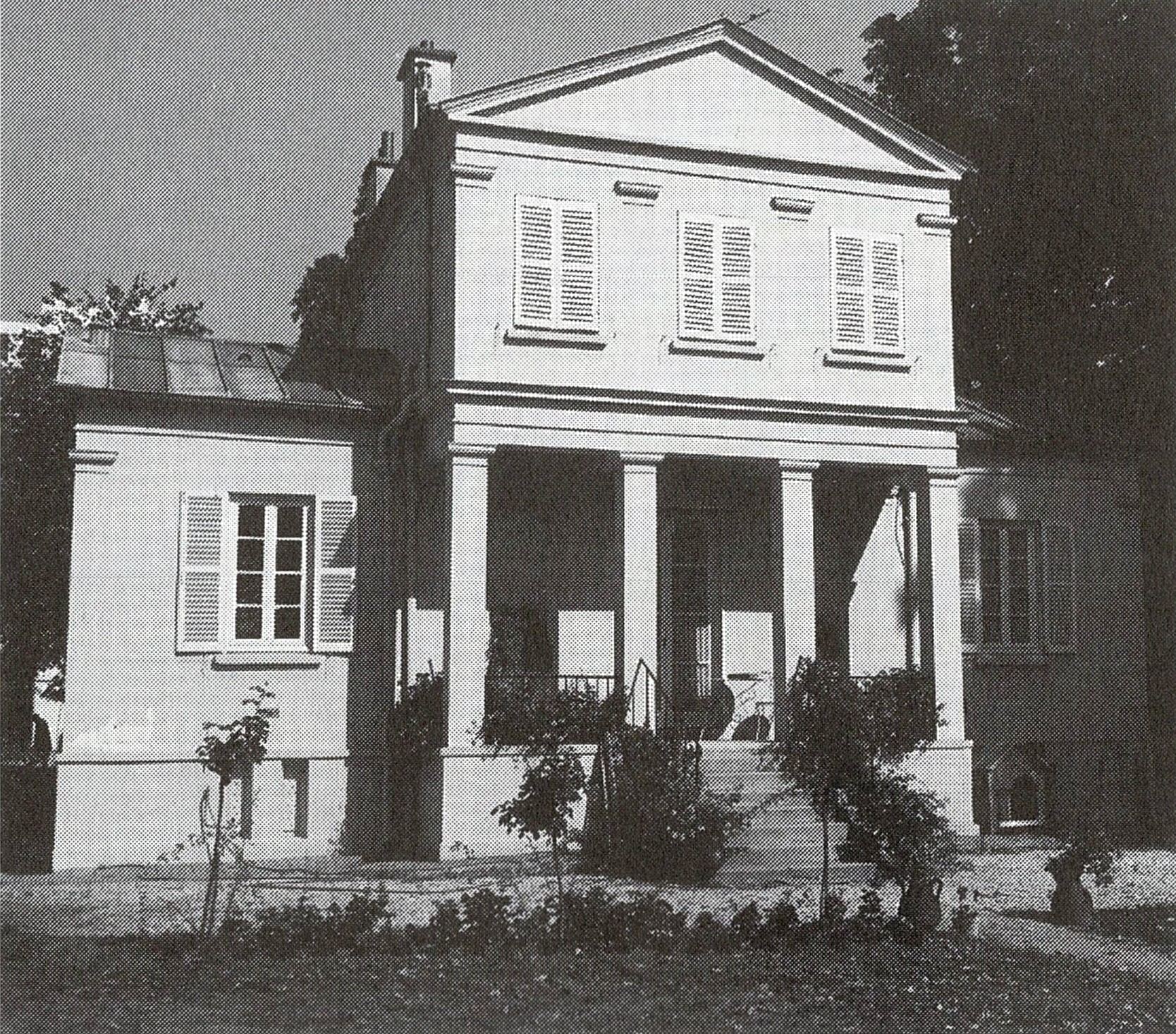
If Pytheos and Durand serve as bookends to the period of Vitruvian-dominated theory, Hejduk elucidates what the world of architecture would look like without Vitruvius at all, so late as he is to such classical and modernist debates. The rational and impartial grid can at last lose the baggage of firmness, commodity, and delight. Besides the proliferation of the computer and digital technology, not much has changed about the discipline between Hejduk and the present, and many of his notions remain fresh today. Educated at Cooper Union—where he would eventually return as a professor in 1964 before being named dean of the school in 1975—, the University of Cincinnati, Harvard Graduate School of Design, and the University of Rome, Hejduk would belong to a couple revolutionary postmodern groups: the Texas Rangers (though they would prefer the First Texas School) with Colin Rowe and Robert Slutzky to name a few, and the New York Five.12 His academic and avant-garde orientations align him with Pytheos and Durand, allowing for a vision of a Pythean architectural theory through his position in the post-Vitruvian era that Durand set in motion.
While the modern practice of architecture emerged during the Renaissance in opposition to earlier notions of the master builder, the profession has long maintained ambiguous boundaries. The Renaissance architects who lay claim to the advent of the discipline in its modern sense were themselves polymaths. The conditions in Pytheos' time were no different as shown by his reputation as a sculptor and theorist. However, some additional clarity here is necessary to avoid the wanton attribution of ancient gridded plans to Pytheos. For instance, the city of Priene follows an urban grid, which has led some to link its design with the gridded design of the Athenaion, making Pytheos a city planner in addition to his other known professions.13 This unsubstantiated claim falls apart upon a closer examination by German archaeologist Wulf Raeck, who contrasts Pytheos with Hippodamus, the city planner of Miletus whom many cite as the creator of the urban grid plan despite its long history before him across the globe. While the professions of city planner and architect share a focus on habitation, they remain exclusive of one another even while bleeding into other disciplines: architects and sculptors overlap, but city planners find themselves with natural philosophers.14 The grid exists across scales and applications, yet it cannot link across them because it links everything. Its unity of everything inherently prevents a united everything. It holds together the mayhem of Manhattan and the beauty of Barcelona, but it will not hold them as one. Unlike in city planning where the grid lives on forever in the layout of the streets, the architectural grid survives only as an artifact of the design process that implemented it to rationalize the creation of a building on the blank page.
The Athenaion serves as the archetype of how the grid can organize architecture. The plan of the building is peripteral with six columns along the short end and eleven along the sides.B While the temple is otherwise Ionic, the stepped bases on which its columns sit fit in better with those of the Doric order.15 Vitruvius lists Pytheos among the ancient architects critical of the Doric order for its clunkiness, so why does he borrow from it, especially in a temple that would become influential in the re-establishment of the Ionic order?16 The plan suggests an answer in its grid, which evenly breaks down into an eleven by twenty-one rectangle: the sum of the columns and their reciprocal intercolumniations on each side. Columns and walls fall centered within an underlying grid layout, which is expressed further in the exposed joints between the square stones that make up the floor of the temple. The only exception to this universal grid lies within the naos, the sacred internal space of the temple, which Pytheos knows houses the gods who transcend even the grid.
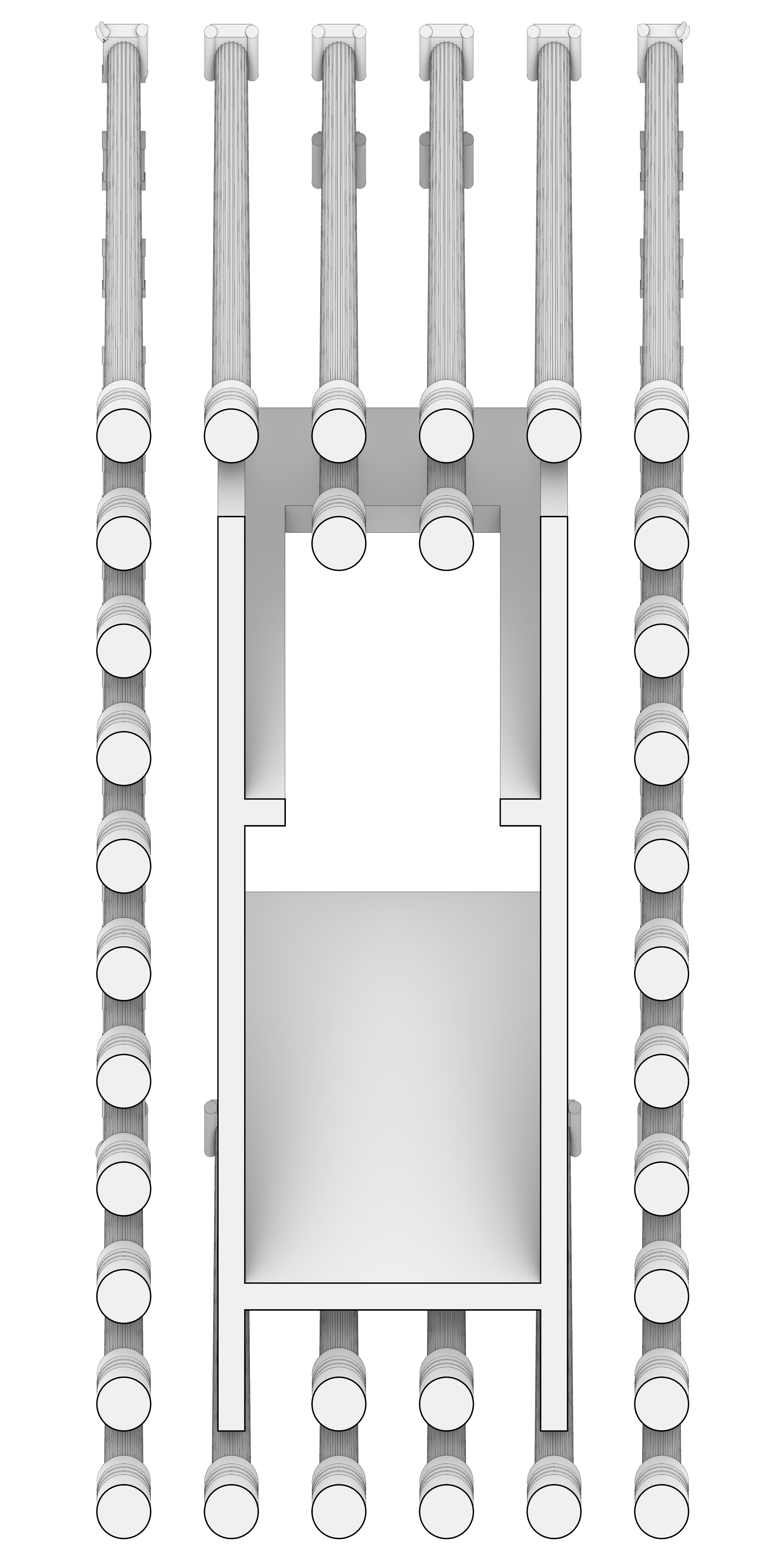
The Athenaion's rational plan layout would quickly become irrational, however, should one realize the dysfunctional relationship between expressly equal columns with their then disproportionately narrow intercolumniations. Pytheos balances the plan with the elevation through the taller, triple-stepped Doric base, which emphasizes the equality between column and void while reducing the column's diameter. The resultant column occupies less space visually with a final intercolumnar spacing of approximately 1¾ column diameters.17 The ⅜ radial difference between each column and its base adheres to Vitruvius' definition of the Ionic order, but the base's increased height differs so that the grid might remain more visible at the ground level. This makes for an incredibly elegant and slender facade, especially as the columns are ten times their diameter in height—another deviation from Vitruvius' regulations.
Vitruvius lays out five classifications for intercolumnar ratios: pycnostyle, systyle, eustyle, diastyle, and araeostyle.C, 18 By Vitruvius' categorizations, such a proportioned temple would be roughly pycnostyle, but like all ancient temples it does not adhere to his proportions exactly. Though he names five, Vitruvius does not treat these styles equally. He chides pycno- and systyles for their "practical disadvantages. When matrons mount the steps … they cannot pass through the intercolumniations with their arms about one another, but must form single file," and the narrow cluttering of their columns cramps and casts shadows on its interior.19 Meanwhile, diastyle has a propensity to break its architraves "on account of the great width of the intervals."20 However, in araeostyle, the widest of the five, this issue necessitates resolution through wooden architraves, though this leaves it "clumsy-roofed."21 Only the eustyle (literally 'good column') is conveniently without flaws, but with additional requirements. Rather than simply specifying the width and height of the intercolumniation based on the column's diameter as he does for the other four, Vitruvius adds another stipulation—one that betrays his predilection for Hermogenes, a Hellenstic architect and Ionic descendant of Pytheos, over Pytheos himself: that the central intercolumniation on the front and back of the temple should be wider, demarcating the entrance and allowing easy passage through a gap tooth-like configuration.22 Pytheos, who doubtlessly worked through the design of the Athenaion meticulously to ensure its final result would resolve both aesthetically and functionally by planning it on a grid, would likely not have accepted that compromised method as 'good.' To him, the order of the grid overruled any natural attempt by an architect to soften the artifice of construction.
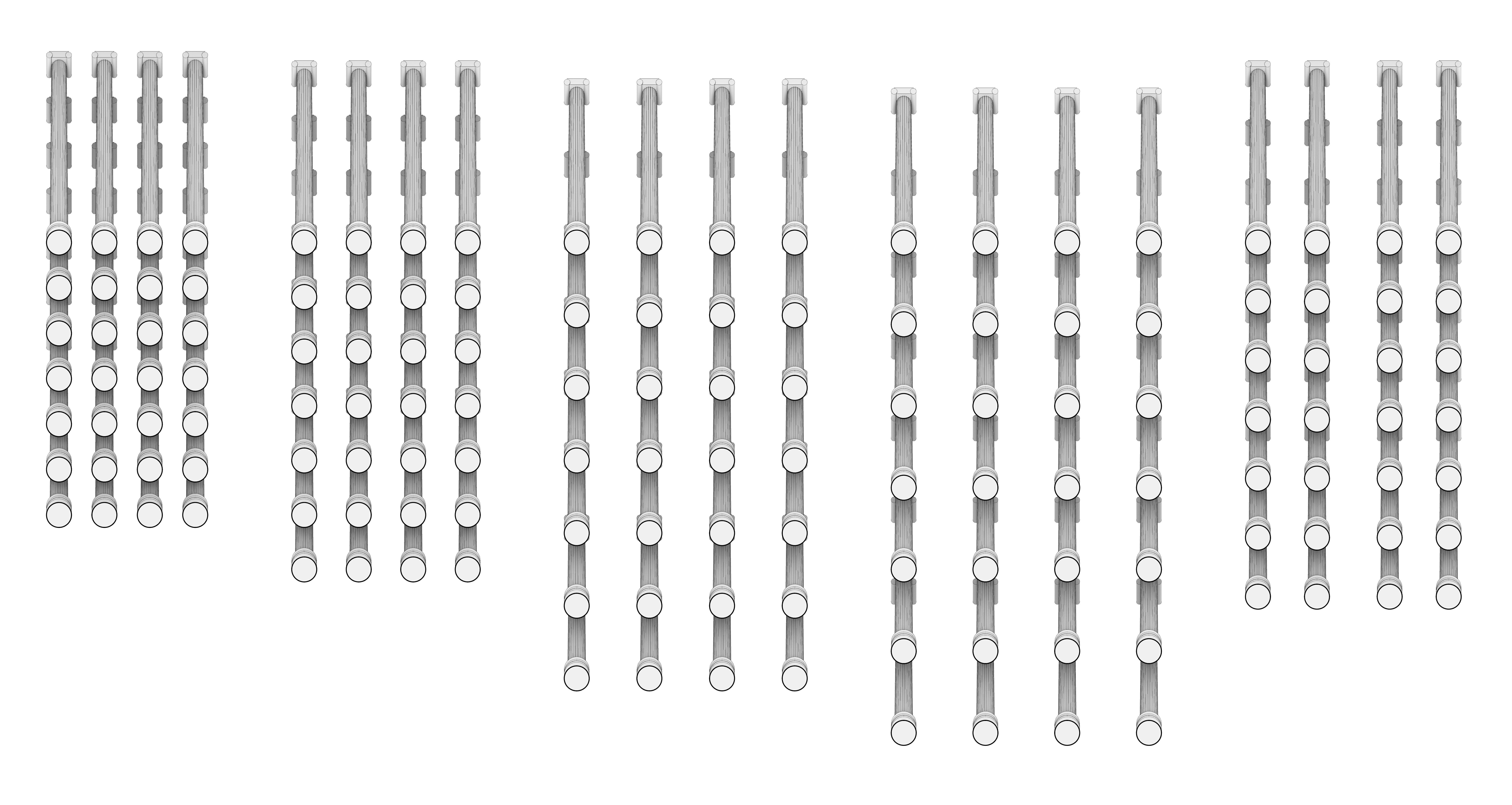
Durand would reiterate this belief in his architectural theories. He explicitly calls out Vitruvius on the stories concocted for each order's origin. To Vitruvius, the proportions of the Doric order descend from those of a man, the Ionic order from those of a woman, and the Corinthian, those of a maiden.23 Durand debunks this both specifically—"a man's foot is not one-sixth but one-eighth his height"—and generally—"within this infinite variety [of Doric manifestations], the exact proportion of six to one is not found in a single case."24 Durand's focus on rewriting a new architectural theory devoid of Vitruvian logic focuses so heavily on this anti-natural approach that he omits the contradictions of the two competing systems that Vitruvius proposes for columns: the five styles and the three orders. The Ionic and Corinthian orders abide within the five styles, but only by rounding intercolumnar ratios. The Doric order creates explicit contradictions. Vitruvius defines the width and height of a Doric column as 1:7 (convoluting his foot-to-man tale of 1:6), a proportion unaccounted for in the five styles, which only get as squat as 1:8. Nevertheless, he discusses the dia- and systyles in relation to the Doric order without any attempt to reconcile the modular system he describes specific to the order with that of the intercolumnar proportions already disclosed.25 For an architectural theorist who puts much value in the relationship between things, he fails to relate his methods of relating. The five styles and three orders butt heads.D This and other loose ends introduced throughout Vitruvius' proposed codifications unravel his theory. Once again the artifice of his pseudo-natural theory becomes apparent. A Pythean theory avoids paradoxes as the grid does not allow any flexibility, making it inherently universal. Either a building follows it, or it does not. It is proudly artificial.
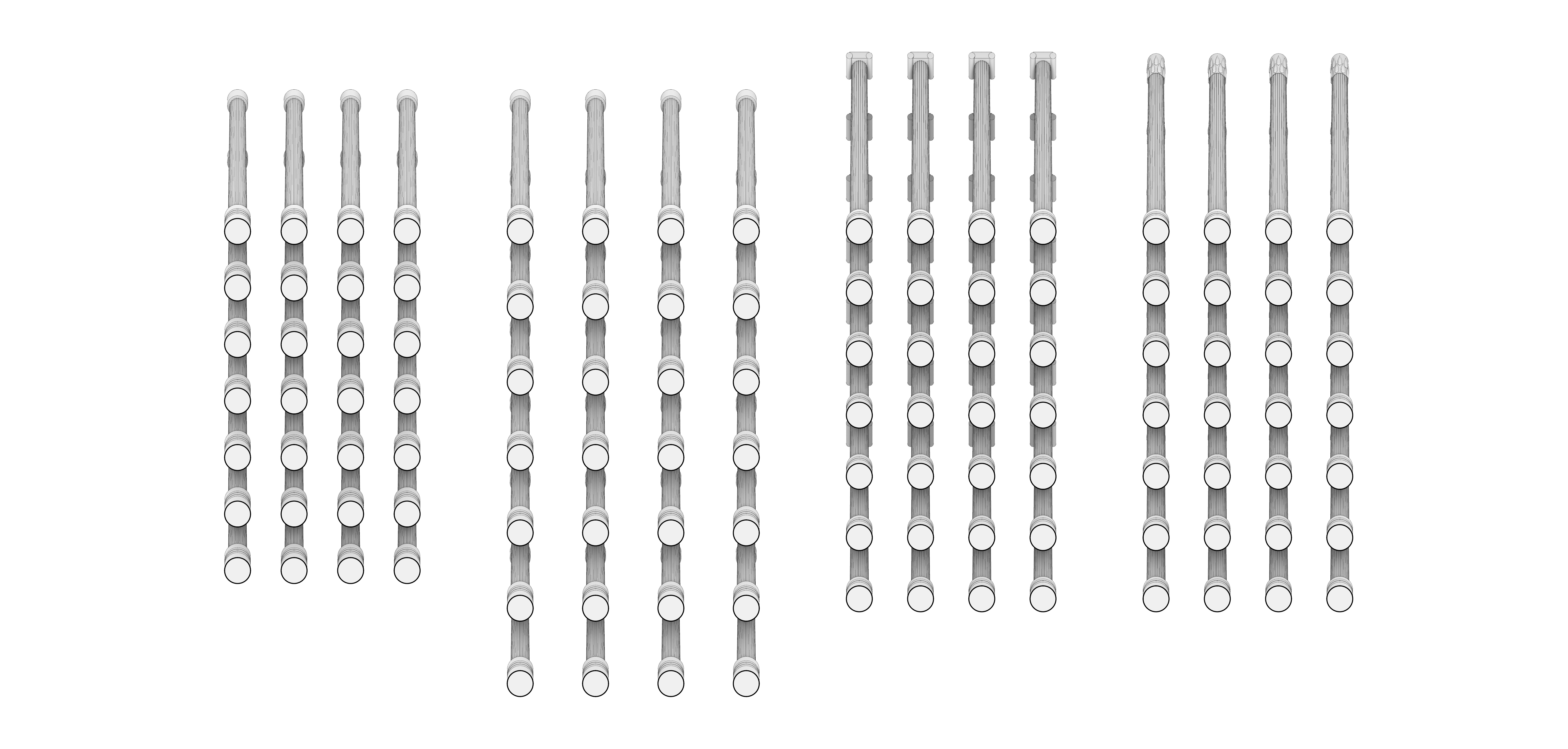
The orders remained a powerful force in architectural theory, and even Durand could not help but propose his own dismissive codification of them and their intercolumnar proportions: Doric, Tuscan, Roman Doric, Ionic, and Corinthian.E Durand, however, accepts the artificiality of their construct, assigning order after the fact as decoration:
Consider which rooms are principal and which are subordinate; which rooms must be adjacent to or remote from certain other rooms: and establish their position and size in consequence. … Once these observations are made … the number of interaxes in each room must be determined and noted… . The greater or lesser number of interaxes in each room determines the order to be employed there…26
Although he initially uses it in the definition of his own orders, Durand immediately abandons Vitruvius' intercolumniation in favor of interaxial measurements. "The unit to which we shall refer all quantities in architecture will be the inter-axis: that is to say, the distance between the axes of two columns."27 Rather than basing his treatise on edge-to-edge measurements of negative space, Durand designs centerline to centerline. This approach recenters the grid, taking columns not as points separated by the absence of points, but as points along a line that has in turn been intersected by perpendicular lines at equal intervals: a horizontal grid. Like Pytheos', Durand's grid is equal and true. Vitruvius' is happenstance, and subject to whimsical alterations like the Hermogenic split.
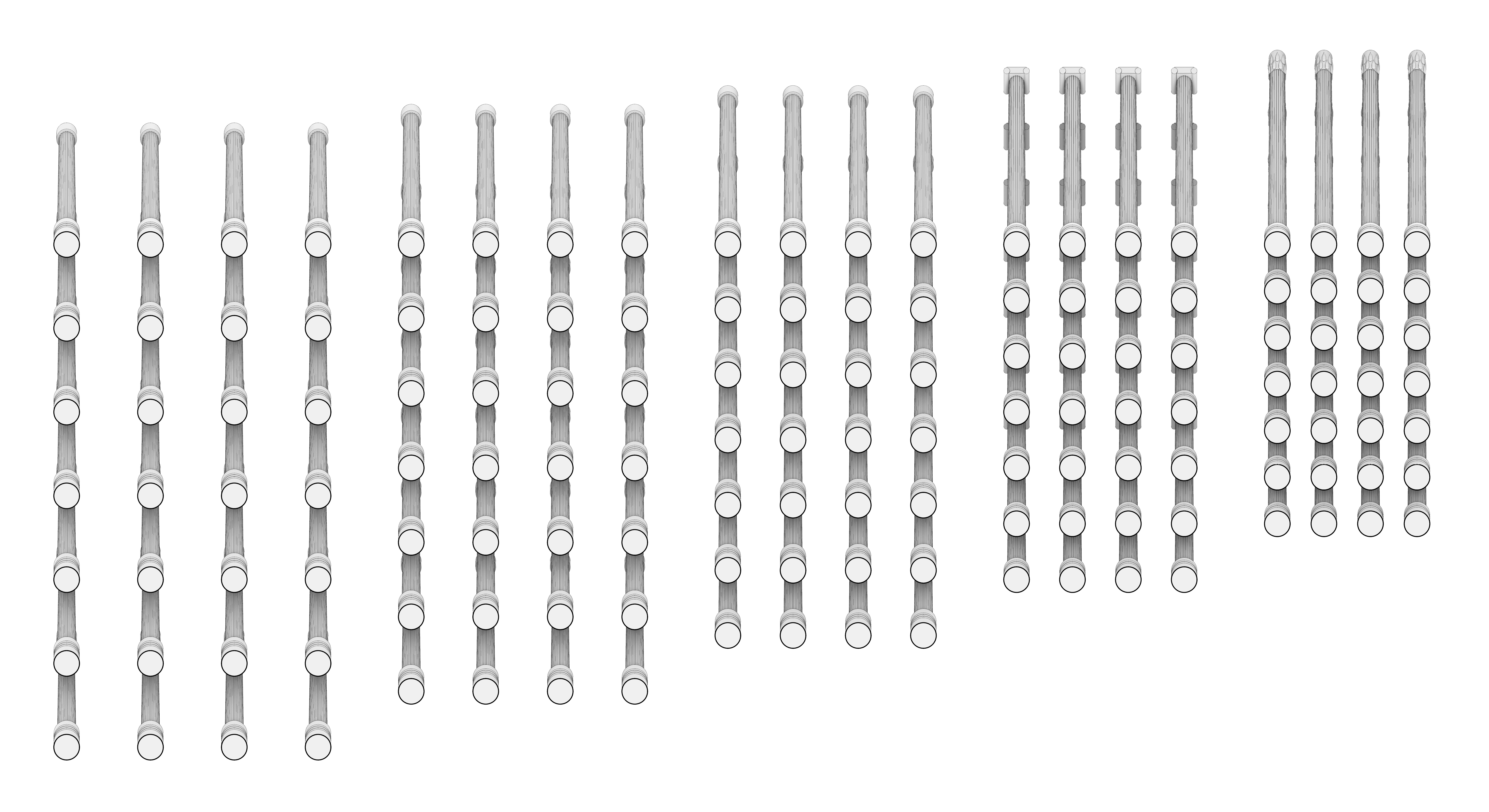
When viewed through an interaxial lens, the Athenaion makes more sense than as an intercolumnar endeavor.F Its equal spacing wavers between interaxial and intercolumnar layouts as each is the other's bisecting grid. Whereas other intercolumniations might produce uneven rhythms in their grids, Pytheos' creates a system which can be further subdivided to provide a higher resolution when necessary. While Pytheos considered the negative space of his design, his altered bases and rigorous grid plan point to it as an affect, not a fundamental design principle. By numbering the columns six by eleven, the Athenaion fits Vitruvius' sensible note on how to avoid visual unevenness: "columns should be so placed that there are twice as many intercolumniations on the sides as there are in front;" however it deviates from the next clause: "for thus the length of the work will be twice its breadth."28 By strictly adhering to a single interaxial measurement, the Athenaion's dimensions deviate as previously calculated.
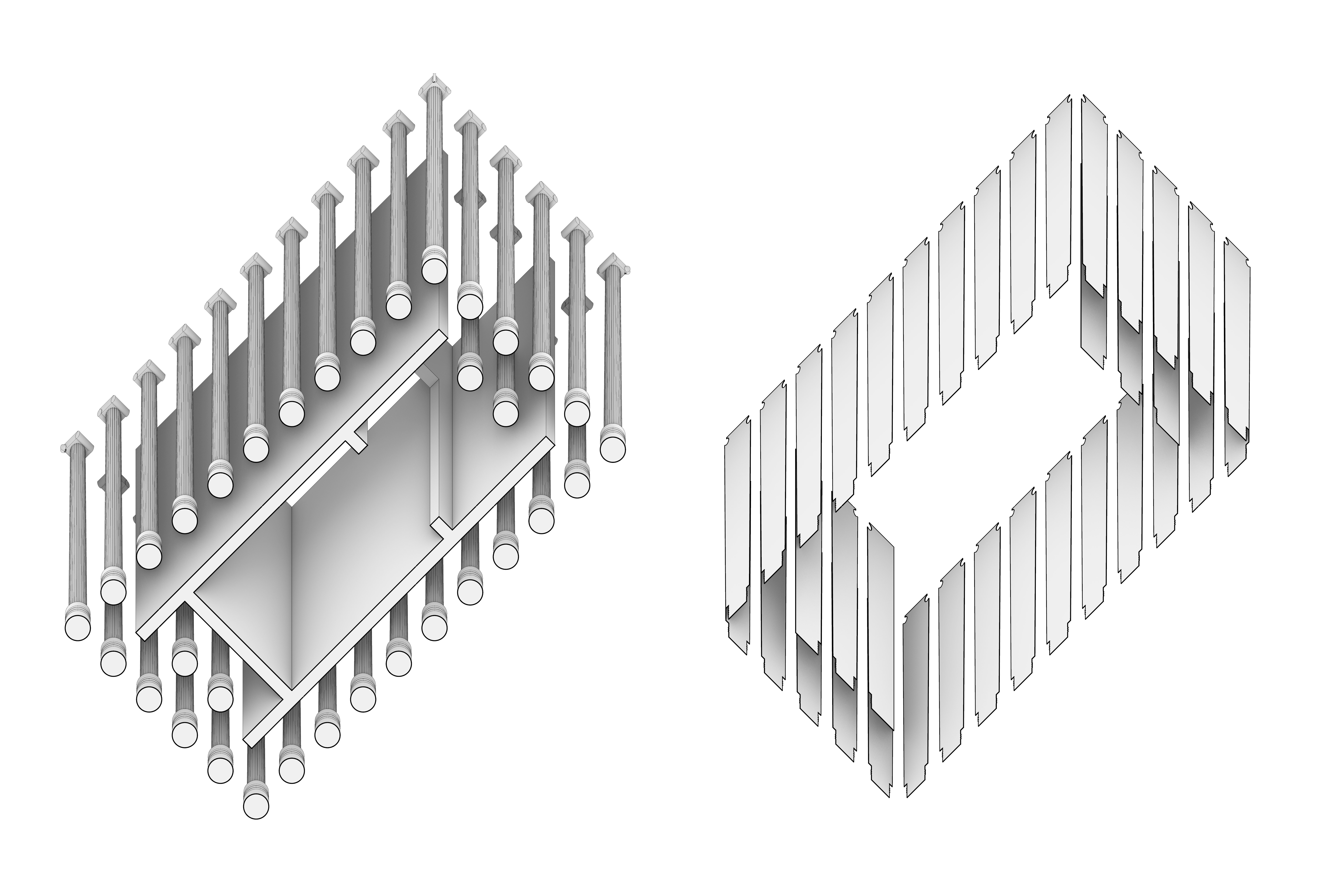
The fussiness of Vitruvius' method forces architects to focus on geometric calculations rather than on the composition of their design. Durand identified and addressed this problem. "Columns," he writes, "must be equally spaced with any given building; but their spacing must vary with circumstances."29 These circumstances are not dependent on a set of styles or orders, but on the function of the building. Wider arrangements are preferable in private buildings to lower material costs while public buildings should have a narrower spacing to improve their longevity.30 Once the architect determines the appropriate spacing, which Durand notes can be revisited later in the design by simply changing the number of interaxes in relation to their subdivision of the site, the composition can follow without any more concern for overly precise regulations.31 The grid provides an easy, universal, and rational method through which to lay out a building. Utility and disposition can lead the design effort as Durand believes they should.
Hejduk takes this a step further in his nine-square grid exercise for first-year architecture students. This assignment provides students with an existing superstructure: a four-by-four grid of evenly spaced columns. As an initial exercise, the nine-square grid removes overall composition from the equation, presenting students with an architectural framework within which they may design and discover more about the discipline.G The spacing and height of the grid are given, but rather than confine and confuse as Vitruvius does with his many regulations, it elucidates design principles as Durand sought to do with his simplification of existing plans. However, unlike Durand's learning-by-seeing method, the nine-square grid allows students to learn by doing, gaining an understanding of "the elements of architecture: lattice, grid, pile, beam, flooring, centre, periphery, field, edge, line, plane, column, extension, compression, tension, translation, etc."32 This is not to say the nine-square grid departs from Durand; it reinforces.
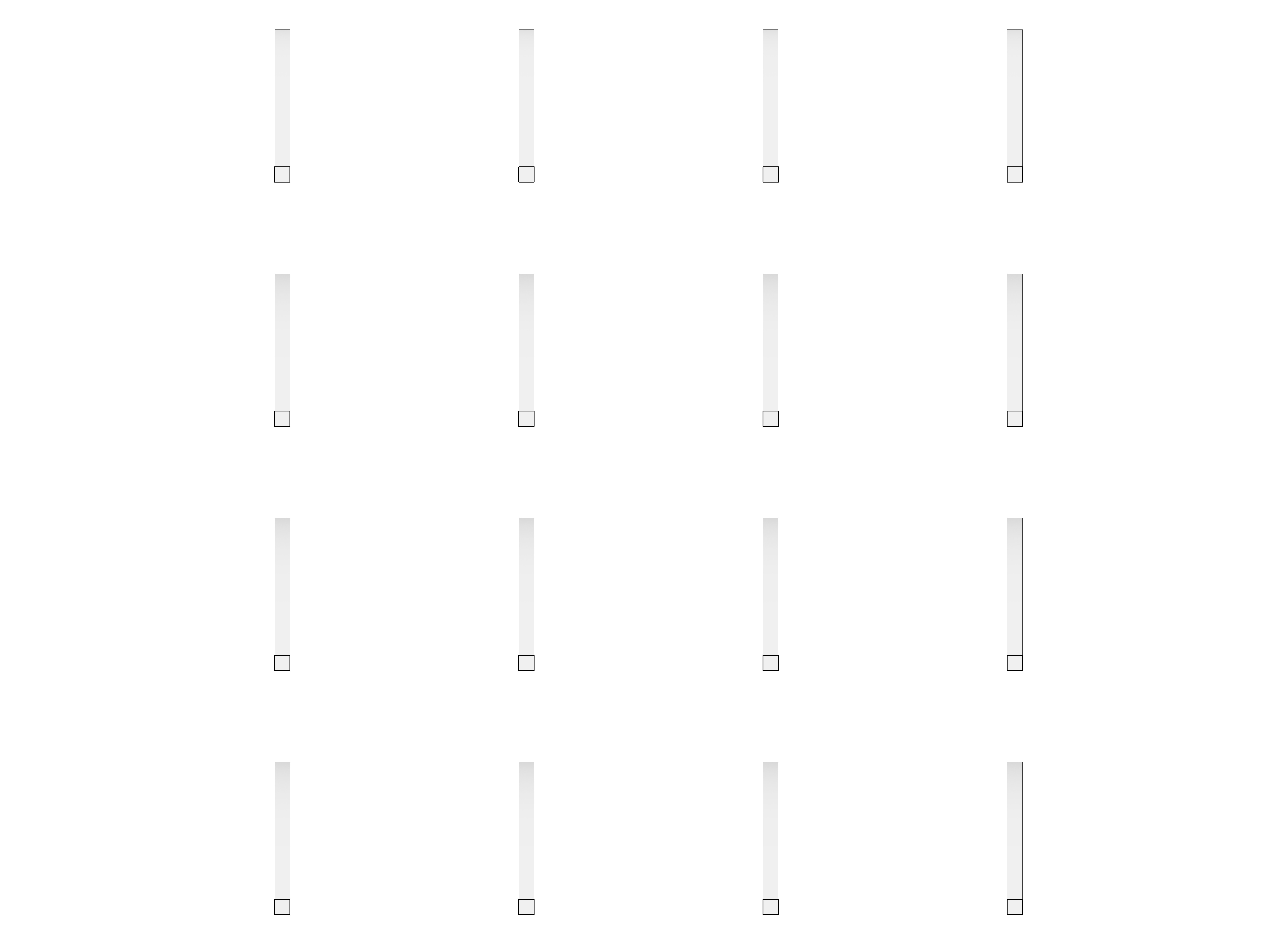
In his discussion of how to form parts into a unified whole, Durand notes that "four axes … form a square. One or two of the four may be omitted; and this will produce two new dispositions. … Dividing a square in two with a new axis, either in one direction or the other, or sometimes in both … will give rise to different plans."33 Learning simple axial relations undergirds any attempt to create holistic architecture, and while the grid abets this effort, the designer must still have an understanding of the issue. "It is essential that the student should become aware as soon as possible of the difference between squares broken up in different ways, … the 'nine square grid' gives the student the opportunity" to gain this understanding through their own experimentation.34 Rather than puzzling over why the floor in the Athenaion's naos breaks from the grid, the nine-square grid readily allows the discovery of the unusual and special condition found at the center of a grid segment.
The grid creates a space where anything can occur without breaking the rules, and allows anything to coexist within an order that simultaneously does not enforce itself onto them. "The neutrality of the supporting structure … emphasises the elements, whose importance as such is underlined by the fact that they are not forced into series or sequences, but always remain intact and discontinuous."35 This produces an architecture that can accommodate much more than one that follows the arbitrary rules of Vitruvius: an architecture that relies on the compositional power of the plan. The building embodies its process, meaning "what Durand actually described is a step-by-step transformation … of geometry into architecture."36 Indeed, Durand's aforementioned parallel between drawing and architecture against lettering and literature reveals how the language used in architecture's composition affects how it can be read. It also shows how Vitruvius misreads by focusing on the resultant intercolumniations instead of on the design-oriented, objective approach of the grid. While the grid orders and residual traces of it remain, its architecture need not bear any obvious mark of its originator.
While architects in ancient times certainly drew, no known traces of such drawings exist before the fourth century ʙᴄᴇ. The earliest surviving example depicts the pediment of the building in which it is etched: none other than Pytheos' Athenaion at Priene.H, 37 This type of drawing—a carving presumably made during construction to resolve a detail or elucidate a condition to the site workers—reappears throughout the following centuries, and could have been an enlarged copy of the working drawings done on papyrus.38 By current knowledge, the history of architectural drawing therefore begins with Pytheos. The gridded layout of the Athenaion adds further proof of Pytheos' draftsmanship as the strict adherence of the buildings' intercolumniation to the square grid would not resolve readily without prior planning, even with the Ionic order's freedom of the frieze. Such a layout, though seemingly simple in its consistency, requires careful attention in order to ensure that an equally sized stylobate, base, and interaxes would not only accommodate visitors without being too narrow, but that each piece of stone would be appropriately sized to fit into the uncompromising scheme. The grid appears obvious after and before the fact, but its rigidity in both directions can quickly become a sticking point during the construction process as any architect who has dealt with alignments on-site can testify.

Other than the tracing of the elevation on the final building and the grid traces of the plan in the final building, the types of drawings Pytheos would have made cannot be determined without secondary sources. Vitruvius offers clarity as to what would be expected of architects at the time, naming three drawing types: "groundplan, elevation, and perspective."39 He instructs that both the plan and elevation be drawn precisely through the use of compass and rule or proportional systems, but for the perspective, long before the advent of true perspective in the Renaissance, he suggests "sketching a front with the sides withdrawing into the background, the lines all meeting in the centre of a circle."40 The techniques of compass and rule were known at the time of Pytheos, so the generation of a precisely square grid would have been trivial in the construction of the plan and its repercussions in elevation.41 Perspective, on the other hand, would have been unimportant to Pytheos' grid layout besides as a crude visualization tool.
In fact, the Vitruvian tradition of perspective, culminating in its codification by Brunelleschi in the fifteenth century and subsequent propagation throughout architecture, goes against Pytheos' alternative grid tradition. When Vitruvius' grasp of the discipline finally loosens, Durand declares that while "perspective alone might give the true idea of the effect of a building … it is strictly forbidden."42 Instead, Durand proposes his own three drawing types: "(1) the plan, which represents its horizontal arrangement; (2) the section, which conveys its vertical arrangement or its construction; (3) and, finally, the elevation, … which is not and cannot be anything other than the outcome of the other two."43 Durand diminishes the power of the elevation, favoring the rationality of plan and section, the latter of which was unknown to Vitruvius. However, the idea of the section elucidates some of the stray lines in Pytheos' sketch, allowing it to perform as an X-ray elevation: a much more useful drawing in the process of the temple's construction than a pure elevation, which would logically be elsewhere on site where it could be referred to while in view of the exterior, not inside the cella. Following the rationality of the grid, the logic of construction dictates drawings that do not reflect reality, favoring instead the artificial process used to achieve it. Perspective drawing does not assist in the invention of architecture; it visualizes already-designed architecture to others, or sketches out phenomenological ideas that forefront human experience over architectural execution. Even Durand's elevation only exists to carry out the implications of the interior to the exterior: a final projection in a series of projected drawings. The plan and section, two views that can never be seen, only ever drawn, allow the architect to design.
Notably, Vitruvius and his rivals agree on the centrality of the plan in architecture. Both he and Durand put it in the privileged first position among their drawing types. Hejduk acknowledges the power of the plan, noting that "throughout the history of architecture, plans have changed the least. … The plan returns architecture to a state of timelessness. The plan has no need for clothes or ornamentation; it carries with it an evitability."44 While Durand would never conflate drawing with architecture, he champions the primacy of the plan in architecture's generation. The plan, however, has one shortcoming that keeps it from holistically representing the work it depicts and organizes: it is flat while architecture is spatial. Hejduk develops a tricky solution to this problem. A hitherto unmentioned form of architectural representation—the axonometric—provides a way forward. Parallel perspectives appear in Western drawings as early as Pytheos' time,I and have long since allowed architects to draw dimensionally accurate spatialized drawings.45 Doing so, however, typically requires either skewing or rotating the plan from its natural, timeless state. Through a series of experiments with diamond and square plans, Hejduk developed the techniques for an axonometric drawing in which the plan can remain exactly as it always is.J In such a drawing, "both plan and front elevation are undistorted … which for [Hejduk] implied a kind of deep space present in the compressed surface of the drawing."46 In the spatialization of the plan, the elevation consequentially returns, forging the entire architecture within a drawing, and "calling attention to the drawing as artifice."47 In the case of Pytheos, Durand, and Hejduk, the artificial nature of the drawing reflects the method in which it generates its architecture, namely the grid, and the artifact that the process will inevitably and desirably leave behind in the final product.
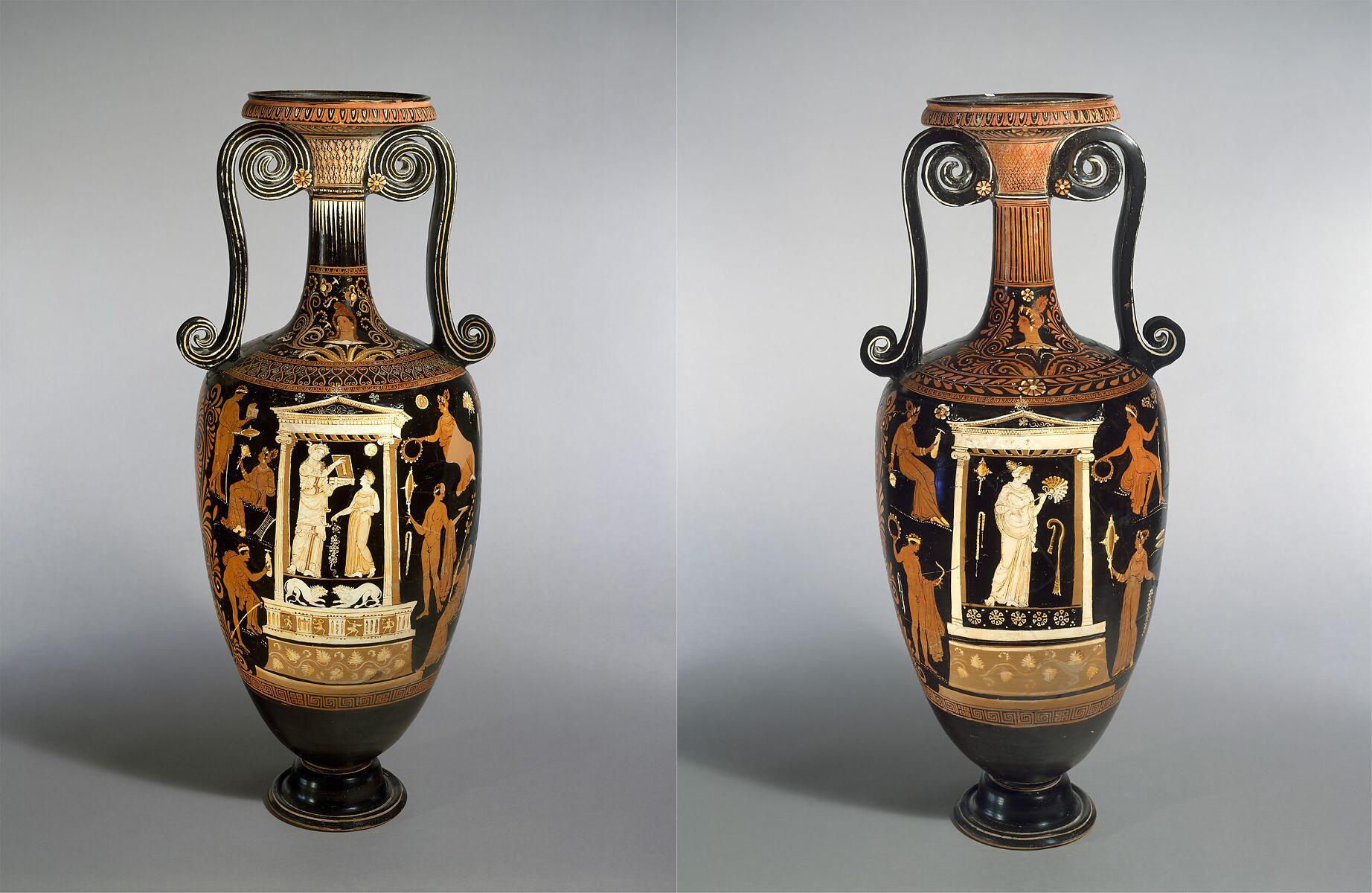

The introduction of yet another drawing type beyond the zero-degree axonometric reveals the inner workings of figures B–G: the ceiling plan. Unlike their more common reflected cousin found in today’s construction drawing sets, the ceiling plan mirrors the floor plan on the page—or rather it chooses to look up rather than down. The symmetrical grid and Greek temple render this mirroring of the plan moot. Stylobates and coffers might contextualize the drawing directionally, but are too easy to exclude when looking at a portion of the building such as the column grid as done here. Building the drawing from the ground up can prove more representationally productive through the reintroduction of the axonometric. In the ceiling plan’s subsequent spatialization, the elevation reappears, undistorted and unfoldable. The drawing’s skyward projection mimics the aspirations of material construction, yet actually commits its depicted spaces to the confines of the drawing. Its spaces cannot escape the primacy of the plan, printed beneath and thus in front of the building it generated. The worm’s-eye, zero-degree axonometric discloses the translation that occurs between the overwhelming grid of the plan and the more elusive grid of the elevation before its near disappearance in the perspectival eyes of the built reality. The drawing type simultaneously shows the planar and spatial ramifications of styles, orders, and exercises. It reifies the transcendent grid. It is a Hejdukian representation of a Durandian rationality, which recreates Pythean space and the architectural theory embodied therein.
Beyond gleanings from his built work, the beliefs of Pytheos remain for the most part an unverifiable mystery due to the loss of his treatises. Vitruvius passes on only a handful of his theory: Pytheos believed that "an architect ought to be able to accomplish much more in all the arts and sciences than the men who, by their own particular kinds of work and the practice of it, have brought each a single subject to the highest perfection;"48 he dismissed the Doric order for its "faults and incongruities … caused by the laws of its symmetry;"49 and he was a proponent of the Ionic order as shown in the revival following the Athenaion and his book on it.50 Most interestingly, Vitruvius makes clear that the two do not see eye to eye. "It appears, then, that Pytheos made a mistake," he writes, "by not observing that the arts are each composed of two things, the actual work and the theory of it."51 Vitruvius divided knowledge into pools, and despite the architect's necessity to be well-versed in numerous disciplines (on this Vitruvius and Pytheos agree), there remained a difference between the specialized knowledge of doing the work and the general scholarship applicable to all fields through theory.52 This distinction between practice and theory remains to this day, but by rediscovering the Pythean alternative, it becomes possible to collapse this dichotomy, generating architecture that operates both physically and theoretically at once.53 Even the neo-Vitruvian architect Andrea Palladio achieves this in his Villa Rotunda, showing the distinction is not as essential as Vitruvius believed.54 "The realization that the hand and mind are one," writes Hejduk, "working first on principles, and filling these principles with meaning through juxtaposition of basic relationships … opened up the possibility of argumentation" within architecture itself.55 Architecture has the potential to teach outside written theory. Pytheos' Commentaries may be lost, but their contents live on, enciphered in the ruins of the Athenaion.
Durand's large body of writings and drawings achieves the same alignment between work and theory, embodying each within the other. The result is a series of drawings from which one could rewrite his Précis, or vice-versa. Durand engineered a reproducible architecture that simultaneously does not diminish the creative energy required from the architect. Like Pytheos, he saw the mechanism of architecture as something to celebrate, not attempt to explain away through fanciful anecdotes. Vitruvius' theory followed its architecture, trying to make sense where there was perhaps none to be made, and left architects with retrospective instructions as to how to design new buildings. Durand's theory preceded and coincided with its architecture, becoming one with it, and allowing future architects room to play despite its rigid limitations. Only with the dawn of industry could architecture finally return to Pytheos' rationality—his merging of architecture and theory. Despite only beginning to dislodge architecture's Vitruvian shackles, Durand managed to articulate a new form of architectural teaching that in fact predated the ancient regime he rebelled against:
By codifying architectural knowledge in the form of a method, it becomes objective: it can be transmitted to and be applied by other architects; in other words, it becomes scientific. … By the beginning of the nineteenth century, architecture could no longer stand as a link between the world of nature and the artificial world of human-made creations. Architecture became part of a system of abstract ideas and concepts, self-sufficient and detached from the natural world, its ultimate purpose to replace nature itself.56
Pytheos' grid triumphantly returned, and with it an autotelic architecture. This is an architecture whose relationship with history is on its own terms. History does not dictate architecture, nor does architecture mimic history. It is a late architecture that "revises past events, takes up where the masters had left their exploration, and makes things happen as if they were happening for the first time."57 The novelty of Durand and Hejduk betray how Pytheos remained, lurking behind the magnificence of Vitruvius, and waiting for the day when architecture could once again return to its senses. Orders come and go, but the grid goes on forever.
The theory suggested from the Pythean grid is fittingly flat. It collapses drawings into their respective buildings through preserving their generative grid. It merges the teaching and construction of architecture through the embodiment of its theory in its practice and its practice in its theory. It flattens history and the present through its non-retrospective epistemology, preferring experiential experiments to post-rationalizations. As such, any physical manifestation of the grid reveals only a few facets of its greater abstract entity—facets that can only be understood through the grid's reification. At this juncture, the idea of drawing—even Hejdukian drawings-as-buildings—stops shy of fully divulging the architectural theory embodied within Pytheos' grid. In an attempt to resolve this gap, the column grids of the Athenion and Vitruvius' five styles were 3D printed.K Similar to the ceiling plan, the limits of 3D-printing technology invert the typical construction order of the temple. 3D-printer filament cannot span large gaps, making trabeated systems suboptimal due to their requisite beams, especially in grids with larger intercolumniations—reminiscent of Virtuvius' comment on the need for wooden architraves in araeostyle spans. A common practice to resolve this issue is to reorient the to-be-printed object. For instance, a conventional stair overhangs unprintably when upright, but becomes a simple extrusion if laid along its stringer side. Likewise, a gridded enclosure becomes trivial to print by flipping it vertically so that its roof becomes the bed on which to build.L By necessity of implementation, the gridded plan becomes the last layer of the print. Its intial imprint in the creation of the structure closes out its manifestation.
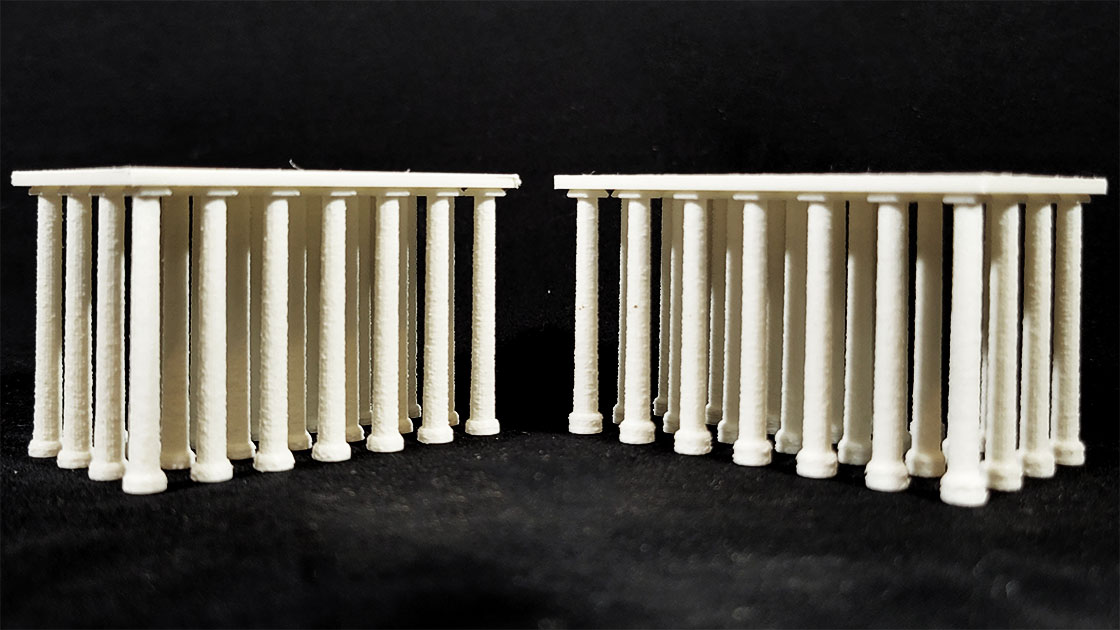

The full extent to which these 3D printed column grids embody previously discussed theoretical discourses on Pytheos cannot meaningfully translate back into textual media. They exist in haptic subtleties, visual parralaxes, shifting light and playful rearrangements.M They enforce the dual nature of Pytheos' praxis by giving form to it, allowing for its methodology to be grasped theoretically and literally due to the coexistent state of the idea and the object.N This exchange undergirds the certain uncertainties of the Pythean grid. Vitruvius synthesized buildings to mythologize architecture. Pytheos architecturalized the mythical to build the synthetic. Without his lost texts, it cannot be determined whether Pytheos was actually the anti-Vitruvius that this essay portrays him as; however it can be historically certain that he was an ante-Vitruvius. In this play on prefixes, opposition comes not from confrontation, but from preceding the origin of conventional narratives of architectural theory: a beginning before beginning, antithesis through paradox. After all, any origin point is just an entry for humans to comprehend and realize the transcendent grid.

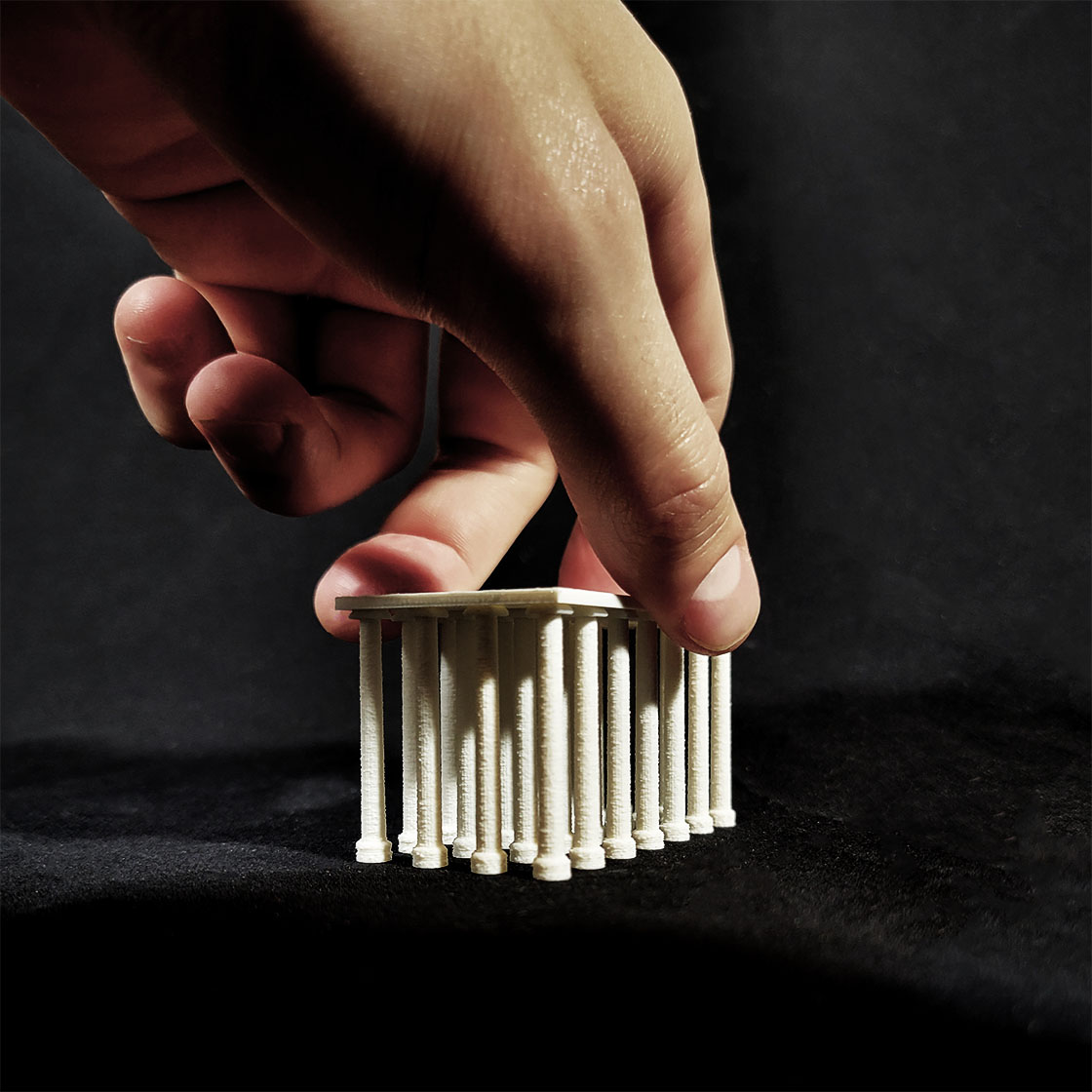
# Date [Return to] Title
500+ Ongoing Essays
550 May 2023 Platform Gamification
504 December 2022 On the Grid
518 December 2022 A Suspended Moment
A–Z Ongoing Glossary
G September 2022 – as in Girder
F May 2022 – as in Formal
* April 2022 – Key
E February 2022 – as in Entablature
D November 2021 – as in Duck
C August 2021 – as in Czarchitect
B June 2021 – as in Balustrade
A April 2021 – as in Aalto
0–15 December 2020 Journal
15 November 2020 Practice (in Theory)
14 October 2020 Alternative Narratives beyond Angkor
13 September 2020 Urban Preservation in Cuba
12e August 2020 Conversation on Copley Square: Summations
12d July 2020 Conversation on Copley Square: Conceptions
12c June 2020 Conversation on Copley Square: Reflections
12b June 2020 Conversation on Copley Square: Nonfictions
12a May 2020 Conversation on Copley Square: Foundations
11 May 2020 Out of OFFICE
10 March 2020 Hudson Yards from the High Line
9 March 2020 Metastructures
8 February 2020 Form, Program and Movements
7 February 2020 Life in the Ruins of Ruins
6 January 2020 The Urban Improvise
5 January 2020 Having Learned from Las Vegas, or Moving past Macau
4 December 2019 A Retrospective on the Decade's Spaces
3 December 2019 The Captive Global City
2 November 2019 Temporal Layers in Archaeological Space
1 November 2019 Contemporary Art Museums as Sculptures in the Field
0 Undated Manifesto: A Loose Architecture
© 2019 – 2023 Win Overholser
Comments
Loading comments...
Powered by HTML Comment Box.